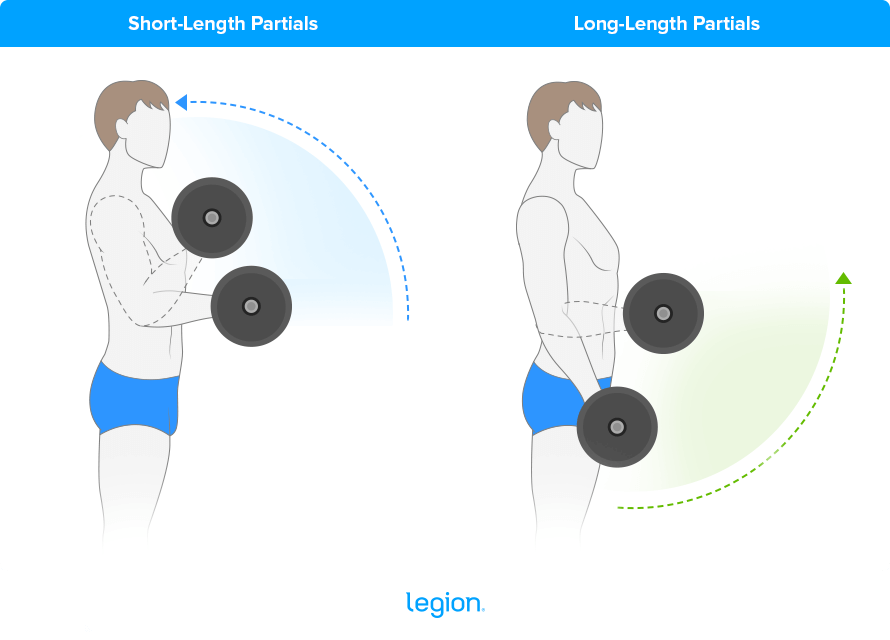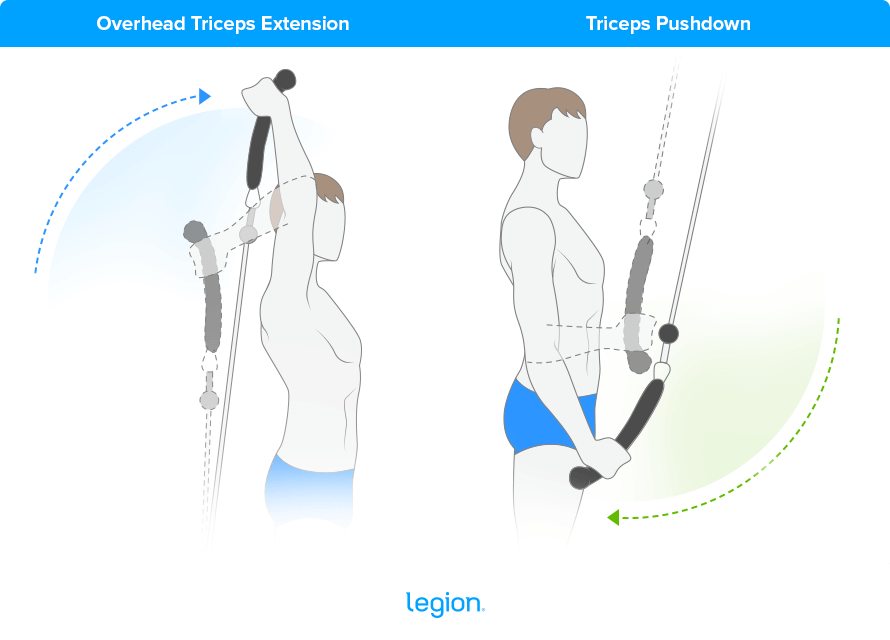Are Lengthened Partials the Key to Rapid Muscle Growth?
Lengthened partials, also known as “long-length partials,” are a training technique quickly gaining acclaim in the fitness space.
They involve only training a muscle while it’s stretched, skipping the part of each rep where the muscle fully contracts.
Advocates of lengthened partials suggest this approach can enhance muscle growth by up to 10%, a figure they claim research supports.
Is this true?
And if so, how should you include them in your program?
Get evidence-based answers to these questions and more in this article.
What Are Lengthened Partials?
Lengthened partials, or “long-length partials,” are a training technique where you intentionally shorten an exercise’s range of motion (ROM), performing only the portion of each rep where your muscles are most stretched.
For instance, in a standing dumbbell curl with full ROM, you lift the weight from your thigh to your shoulder by bending your elbow. However, you can divide this ROM into two sections: the “top portion” and the “bottom portion.”
In the top portion of each rep, from where your forearm is parallel to the floor to where your hand reaches your shoulder, your biceps contract more and are shorter. Performing reps in this partial ROM are “short-length partials.”
Conversely, in the bottom portion of each rep, starting with the weight by your thigh and ending with your forearm parallel to the floor, your biceps stretch more and are longer. Performing reps in this partial ROM are long-length partials.
Here’s a diagram illustrating the difference:

Long-Length Partials vs. Short-Length Partials
Gym-lore has long suggested that while stretching a muscle during an exercise aids growth, fully contracting and “squeezing” it is paramount.
And while this theory seems logical—contracting a muscle feels like it’s doing more for growth than stretching it—a wealth of new research shows otherwise.
For example, in a study by Ritsumeikan University, scientists had 21 weightlifters do 2 weekly triceps workouts. In each workout, the participants trained one arm with the overhead triceps extension and the other with the triceps pushdown.
Crucially, the weightlifters performed each exercise through only a partial, 90-degree ROM.
The researchers chose these exercises and this form because it allowed them to investigate how performing partial reps affects muscle growth when the triceps are stretched (overhead triceps extension) versus shortened (triceps pushdown).
Here’s how each exercise looked:

After 12 weeks, the results were remarkable: the overhead triceps extension led to approximately 40% more growth than the triceps pushdown.
Given the mounting body of evidence, we can reasonably conclude that long-length partials cause more growth than short-length partials. But since full ROM training works your muscles when stretched and contracted, shouldn’t it be even better?
Long-Length Partials vs. Full ROM
Recent studies suggest long-length partials offer an advantage over full ROM training for muscle gain.
For example, in a study by the State University of Londrina, 42 women performed calf raises 3 days weekly for 8 weeks. A third of the women did long-length partials, another third did short-length partials, and the remainder did calf raises through a full ROM.
The results showed that those who did lengthened partials gained significantly more muscle (~15%) than those who did shortened partials (~3%) or full ROM calf raises (~7%).
Nevertheless, there are several reasons why you probably shouldn’t replace full ROM training with lengthened partials just yet:
- Studies show that active tension—the kind generated when you lift a weight—is vital for muscle gain. That’s why research shows both squats (which stretch the glutes) and hip thrusts (which don’t stretch them much) are equally effective for glute development.
- It’s difficult to standardize ROM on lengthened partials. This makes tracking performance over time challenging and adds a layer of complexity that most prefer to avoid.
- Lengthened partials likely increase strength through the ROM you train, but probably won’t make you stronger through a full ROM. This limitation could affect sports performance or your ability to perform day-to-day tasks requiring strength in various positions and through a full ROM.
- Research on lengthened partials is still new. While the early signs are encouraging, it’s sensible to wait for more comprehensive research before making major changes to your training.
Including long-length partials in your routine can be beneficial: they stimulate growth, add variety to your workouts, and enable you to build muscle when training through a full ROM isn’t possible (due to injury, for example).
However, this doesn’t mean you should forego full ROM training.
A balanced approach incorporating long-length partials and full ROM training is likely the most effective strategy.
How to Include Lengthened Partials in Your Training
You don’t need to perform lengthened partials to gain muscle.
Decades of research and experience tells us that you can build an impressive physique by training through a full ROM. Traditional training is also simpler to track and likely allows you to build more overall strength.
That said, lengthened partials can be a fun and effective addition to training.
If you’re curious to try them, here’s how you can get started.
1. Use lengthened partials for your final exercise or final set.
The most effective way to incorporate lengthened partials into your training is to use them for the final exercise of a workout or in the final set of your last exercise.
While both methods work, using long-length partials for all sets of your final exercise is probably optimal because it maximizes the time you spend in the stretched ROM.
2. Do “integrated partials.”
Instead of performing lengthened partials separately, “integrate” partials in your regular sets by alternating between full range of motion reps and lengthened partials until you get within a rep or two of failure.
Integrated partials ensure your muscles experience both full ROM and the stretched ROM in each set, providing a comprehensive stimulus for growth.
Like the previous technique, integrated partials work best when you use them for your final exercise in a workout or your final set of your last exercise.
3. Extend your final set with lengthened partials.
Say your program calls for 3 sets of biceps curls. On your third set, use a full ROM until you’re 1-to-2 reps shy of failure, then switch to lengthened partials, pushing until you get close to failure again.
Extending your set with lengthened partials is perhaps the most intuitive way to include them in your training. That said, since you spend less time in the stretched ROM compared to the other techniques, it might be the least effective for growth.
Common Mistakes with Lengthened Partials
1. Using poor form.
Many conflate partial reps with “cheat reps” and allow their form to break down during their lengthened partial sets.
Avoid this by treating long-length partials as you would any other set, controlling the weight through each rep’s eccentric (lowering) and concentric (lifting) phases.
2. Not standardizing ROM.
Lengthened partial reps have no clear “endpoint.” This makes standardizing your form from rep to rep and workout to workout challenging and can make it hard to track progress.
To counter this, identify “landmarks” on your body or equipment that help you replicate the same ROM in each rep.
For example, when performing the . . .
- Machine row, row the weight until the handles reach the back of the chest pad
- Bench press, press the weight until your elbows form a 90-degree angle
- Leg curl, curl the weight until your knee forms a 90-degree angle
- Lat pulldown, pull the handle until it reaches your forehead
3. Using the “wrong” equipment.
Barbell exercises often don’t suit long-length partials as you typically have to perform a full ROM rep to rerack the barbell safely.
However, after a set of lengthened partials, you might not have the strength to perform this full ROM rep, making reracking risky.
Therefore, it’s better to use machines or dumbbells for long-length partials. These types of equipment have built-in safety features to prevent injury or allow you to drop the weights safely if needed.
The post Are Lengthened Partials the Key to Rapid Muscle Growth? appeared first on Legion Athletics.
https://ift.tt/HKbr56x December 22, 2023 at 06:00PM Legion Athletics
Comments
Post a Comment